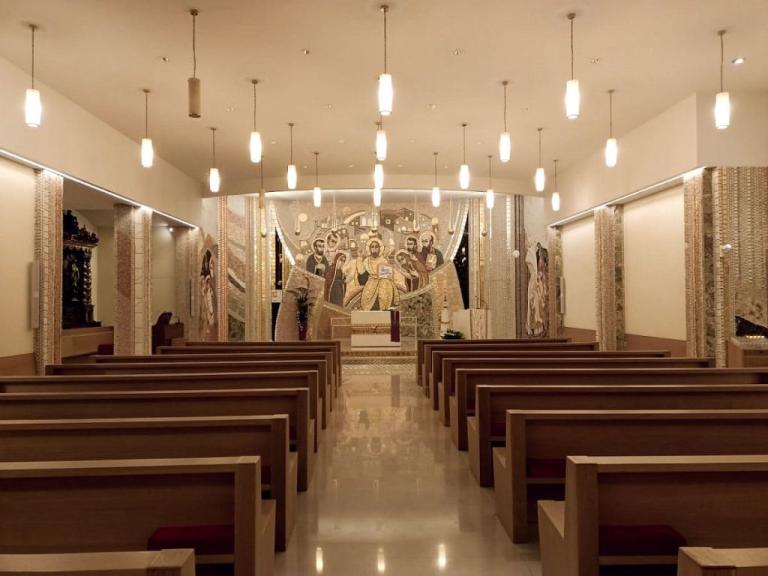
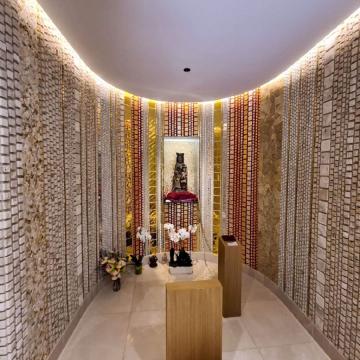
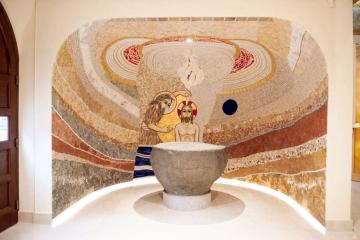
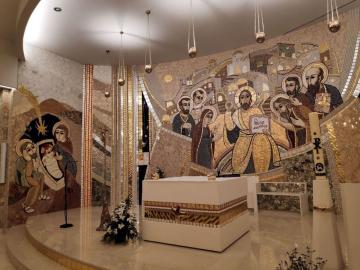
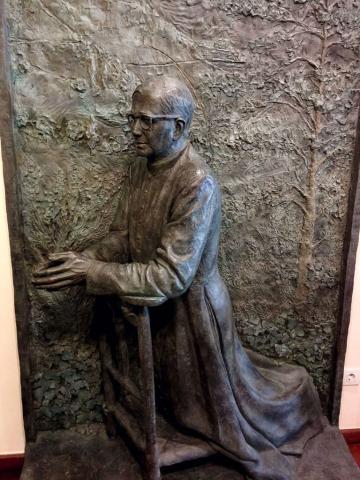
Saint Julian and Saint German of Lòria
Description
Situated in the tranquil parish of Sant Julià de Lòria, the church of Sant Julià i Sant Germà de Lòria serves as a durable symbol of Andorra’s rich spiritual and cultural legacy. Designated as a Site of Cultural Interest, this architectural masterpiece exemplifies a captivating blend of Romanesque foundations, Baroque modifications, and modern artistic contributions. Throughout the years, it has preserved its religious core and historical importance, while adapting to the artistic and architectural trends of different periods.
Sant Julià i Sant Germà de Lòria, originating from the Romanesque period, with a prominent Lombard-style bell tower on its northern side. The tower is composed of precisely aligned stone blocks secured with lime mortar, topped with a roof covered in llicorella slabs. Elevating in three stages beyond the current roofline, it features paired windows encased in semicircular arches, their voussoirs imparting a sense of stability and elegance. Over time, alterations, especially at the highest level, modified these holes to accommodate bells. The tower’s architectural sophistication is enhanced by a frieze of blind arches, a hallmark of its lasting Romanesque legacy.
The 18th century introduced significant alterations, transforming the nave and apse into a rectangular form. A significant modification transpired in 1940 with the destruction of the ancient nave, facilitating the construction of a newly built edifice characterized by a rectangular configuration and a façade composed of granite. The 20th-century renovations introduced a contemporary sensibility while preserving the coherence with Andorra’s historic architectural style. The nave’s subsequent development in 1974 led to the elimination of the common room and cemetery. Furthermore, the spatial realignment relocated the Baroque apse at the church’s base while transforming the 1940 granite façade—embellished with vivid stained glass—into the new apse. These intentional modifications guaranteed that the church continued to serve as both a site of historical significance and a practical venue for modern worship.
Within, the church serves as a genuine repository of spiritual and artistic legacy. Among its most valued artifacts are 12th-century Romanesque statues, including the Virgin of Canòlic and the Virgin of Remei. These intricate carvings exemplify the transcendent elegance and deep spirituality characteristic of Romanesque art. Two lavish Baroque altarpieces, dedicated to Saint Julian, Saint German, and the Immaculate Conception, further enhance the church’s artistic range. The principal altarpiece, an exemplary work of early Baroque design, was created in 1622 by Antoni Tremulles and Pere Carreu, but the secondary piece, finalized in 1686 by Isidre Clusa and the Master of Santa Llúcia, exemplifies the sophistication and magnificence of late Baroque artistry.
In addition to these historic masterpieces, the church persists in embracing artistic progress. In 2012, a reflective sculpture of Saint Josemaría Escrivá de Balaguer, crafted by Rebeca Muñoz, was unveiled in front of the previous altarpiece. This homage honors the saint’s journey through the church in 1937, as he crossed the Pyrenees in search of shelter from religious persecution in Madrid during the Spanish Civil War. This significant historical occurrence highlights the church’s function as a refuge of comfort during periods of turmoil.
An important improvement took place in 2019, commemorating the 20th anniversary of the coronation of Sant Julià de Lòria’s esteemed patron, the Virgin of Canòlic. During this extensive refurbishment, some 200 square meters of elaborate mosaics, created by the renowned artist Marko Ivan Rupnik—frequently compared to a contemporary Michelangelo—were incorporated into the church. Rupnik’s work infuses the space with remarkable spiritual and creative depth. His mosaics, depicting radiant Christian iconography, surround the high altar and presbytery, focusing on a simple white altar at the center of the chancel. The primary mosaic features Christ in Majesty, Saint Mary, Saint Peter, Saint Julian, Saint German, Saint Paul, and John the Baptist. On the right, a vibrant Nativity scene illustrates the Virgin gently holding the Christ Child next to Saint Joseph in a serene wooden manger, while on the left, a representation of the Resurrection depicts Christ’s revealing appearance to his followers.
Rupnik’s artistic oeuvre encompasses a chapel specifically dedicated to the Virgin of Canòlic. A polychrome wooden statue of the Romanesque Virgin is housed behind a glass panel in this sacred area. The chapel’s architectural simplicity highlights the statue’s austere, hieratic style—lacking overt expression or movement—evoking the rustic aesthetic of Romanesque heritage. The mosaic, composed of painstakingly designed tesserae, enhances the chapel’s spiritual atmosphere by its vertical and abstract design.
Amid these improvements, the church retains aspects of its Romanesque heritage. One of the most notable objects is the baptismal font, carved from a single block of granite in the latter half of the 12th century. This monolithic font, situated in a side apse, is enhanced with a large mosaic illustrating Christ’s baptism, establishing a concrete link to the church’s historical heritage.
The church’s main façade, facing Verge de Canòlic Avenue, shows the unique characteristics of Andorran granite architecture. Constructed from uneven stone blocks, its corners are highlighted by rectangular friezes. The edifice is topped by a small bell tower-wall featuring stained glass windows and a semicircular-arched entryway. This harmonious integration of ancient and modern elements represents the church’s architectural development throughout the years.
Today, Sant Julià i Sant Germà de Lòria continues to be a dynamic center of religious activity. It functions as a dynamic repository of Andorra’s artistic and cultural heritage and the spiritual center of the parish. The church’s regular liturgical activities, along with its remarkable collection of Romanesque and Baroque art, attract both visitors and worshippers, providing insight into the lasting magnificence and steadfast devotion that characterize this hallowed site.
The architectural evolution of Sant Julià i Sant Germà de Lòria, from its Romanesque origins to its Baroque enhancements and contemporary modifications, illustrates a captivating narrative of devotion and artistic creativity. This revered structure serves as a lasting emblem of continuity and inspiration, reflecting the rich history and evolving character of Andorra to all who enter its historic confines.





